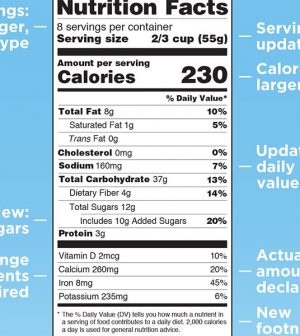- Navigating Your Midlife Crisis: Embracing New Possibilities
- City Raccoons Showing Signs of Domestication
- Mapping the Exposome: Science Broadens Focus to Environmental Disease Triggers
- One Week Less on Social Media Linked to Better Mental Health
- Your Brain Changes in Stages as You Age, Study Finds
- Some Suicide Victims Show No Typical Warning Signs, Study Finds
- ByHeart Formula Faces Lawsuits After Babies Sickened With Botulism
- Switch to Vegan Diet Could Cut Your Greenhouse Gas Emissions in Half
- Regular Bedtime Does Wonders for Blood Pressure
- Dining Alone Could Mean Worse Nutrition for Seniors
‘Added Sugars’ Label on Foods Could Save Many Lives

A new Nutrition Facts label that highlights the amount of added sugars in food could prevent nearly 1 million cases of heart disease and type 2 diabetes, a new study suggests.
The new label, first proposed by the U.S. Food and Drug Administration in May 2016, adds a new line under the Total Carbohydrate category that details the amount of sugar that has been added on top of the sugars already contained in a food product.
If consumers had access to this new label, their food choices could prevent more than 350,000 cases of heart disease and nearly 600,000 cases of type 2 diabetes over the next two decades, researchers predicted using a computer model.
This would save the United States $31 billion in health care costs and $62 billion in productivity and other societal costs, said senior researcher Renata Micha. She’s an associate research professor at the Tufts University School of Nutrition Science and Policy, in Boston.
These effects could be even stronger if the new Nutrition Facts label prompts food manufacturers to reduce the amount of sugar they add to products, Micha said.
“If this added sugar label prompts the food industry to reformulate even a portion of its products to have fewer added sugars, these health and financial benefits would be doubled, which is a staggering impact,” Micha said.
Added sugars account for more than 15% of Americans’ total daily calories, exceeding the recommended level of less than 10%, the researchers said in background notes.
It can be tough to recognize added sugars by looking at the list of ingredients on a label, the U.S. Centers for Disease Control and Prevention says.
Brown sugar, corn sweetener, corn syrup, dextrose, fructose, glucose, high-fructose corn syrup, honey, lactose, malt syrup, maltose, molasses, raw sugar and sucrose are just some of the many different ingredients that contribute added sugars to food, the CDC notes.
To make things simpler for consumers, the FDA proposed a new line on the Nutrition Facts label that totals up all these sources of added sugar. The line would note the number of grams of added sugar and the percentage they contribute to an average person’s daily calorie count.
Unfortunately, the FDA has delayed implementation of the label until 2020, Micha said.
“What these results tell us is that there is a need for timely implementation of this label,” Micha said.
For this study, Micha and her colleagues used an already validated model that takes into account a variety of information — including demographics, risk factors, dietary habits and diseases — to project the impact of the revised Nutrition Facts label on consumers’ food choices, their long-term health, and the economic cost of heart disease and type 2 diabetes.
Previous studies have shown that better information does help consumers make smarter food choices, Micha and her team said. For example, trans-fat labeling led people to avoid products rich in these very unhealthy fats, which prompted the food industry to remove them from products.
Dr. Reshmi Srinath, director of the Mount Sinai Weight and Metabolism Management Program, in New York City, expects the same would occur if people had better information at hand about added sugars.
“In my experience, people are now more conscious of their sugar intake, are reviewing food labels, and want to make healthier food choices. Clear labeling of sugar content is crucial in helping people make these right choices,” said Srinath, an assistant professor with the Icahn School of Medicine at Mount Sinai.
Micha said the most striking finding from the study came when researchers predicted what might happen if the food industry responded to the new label by reducing the amount of added sugars in products.
Even a partial industry response could result in about 700,000 fewer cases of heart disease and 1.2 million fewer cases of type 2 diabetes over the next 20 years, the model shows.
“The industry should be part of the solution,” Micha said. “We saw when we did account for even a modest industry reformulation, maximum health and economic gain can be achieved.”
The new study was published April 15 in the journal Circulation.
More information
The U.S. Food and Drug Administration has an example of the proposed update to the Nutrition Facts label.
Source: HealthDay
Copyright © 2025 HealthDay. All rights reserved.










